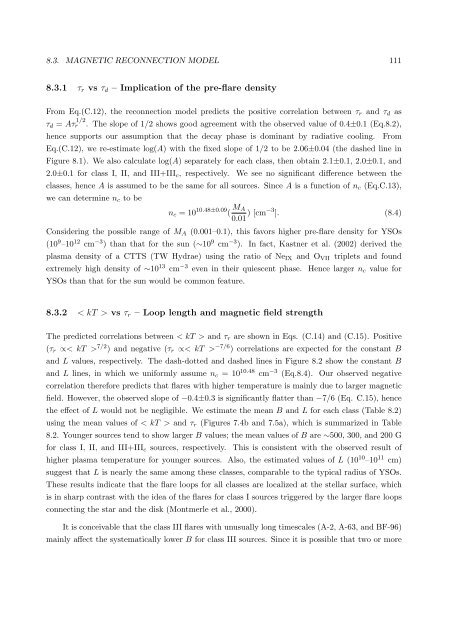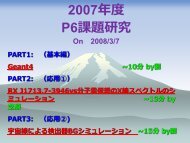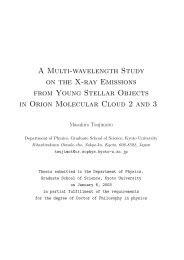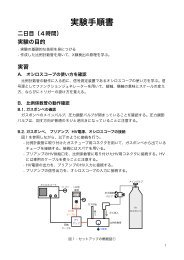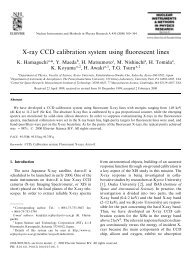X-ray Study of Low-mass Young Stellar Objects in the ρ Ophiuchi ...
X-ray Study of Low-mass Young Stellar Objects in the ρ Ophiuchi ...
X-ray Study of Low-mass Young Stellar Objects in the ρ Ophiuchi ...
Create successful ePaper yourself
Turn your PDF publications into a flip-book with our unique Google optimized e-Paper software.
8.3. MAGNETIC RECONNECTION MODEL 1118.3.1 τ r vs τ d – Implication <strong>of</strong> <strong>the</strong> pre-flare densityFrom Eq.(C.12), <strong>the</strong> reconnection model predicts <strong>the</strong> positive correlation between τ r and τ d asτ d = Aτr1/2 . The slope <strong>of</strong> 1/2 shows good agreement with <strong>the</strong> observed value <strong>of</strong> 0.4±0.1 (Eq.8.2),hence supports our assumption that <strong>the</strong> decay phase is dom<strong>in</strong>ant by radiative cool<strong>in</strong>g. FromEq.(C.12), we re-estimate log(A) with <strong>the</strong> fixed slope <strong>of</strong> 1/2 to be 2.06±0.04 (<strong>the</strong> dashed l<strong>in</strong>e <strong>in</strong>Figure 8.1). We also calculate log(A) separately for each class, <strong>the</strong>n obta<strong>in</strong> 2.1±0.1, 2.0±0.1, and2.0±0.1 for class I, II, and III+III c , respectively. We see no significant difference between <strong>the</strong>classes, hence A is assumed to be <strong>the</strong> same for all sources. S<strong>in</strong>ce A is a function <strong>of</strong> n c (Eq.C.13),we can determ<strong>in</strong>e n c to ben c = 10 10.48±0.09 ( M A0.01 ) [cm−3 ]. (8.4)Consider<strong>in</strong>g <strong>the</strong> possible range <strong>of</strong> M A (0.001–0.1), this favors higher pre-flare density for YSOs(10 9 –10 12 cm −3 ) than that for <strong>the</strong> sun (∼10 9 cm −3 ). In fact, Kastner et al. (2002) derived <strong>the</strong>plasma density <strong>of</strong> a CTTS (TW Hydrae) us<strong>in</strong>g <strong>the</strong> ratio <strong>of</strong> Ne IX and O VII triplets and foundextremely high density <strong>of</strong> ∼10 13 cm −3 even <strong>in</strong> <strong>the</strong>ir quiescent phase. Hence larger n c value forYSOs than that for <strong>the</strong> sun would be common feature.8.3.2 < kT > vs τ r – Loop length and magnetic field strengthThe predicted correlations between < kT > and τ r are shown <strong>in</strong> Eqs. (C.14) and (C.15). Positive(τ r ∝< kT > 7/2 ) and negative (τ r ∝< kT > −7/6 ) correlations are expected for <strong>the</strong> constant Band L values, respectively. The dash-dotted and dashed l<strong>in</strong>es <strong>in</strong> Figure 8.2 show <strong>the</strong> constant Band L l<strong>in</strong>es, <strong>in</strong> which we uniformly assume n c = 10 10.48 cm −3 (Eq.8.4). Our observed negativecorrelation <strong>the</strong>refore predicts that flares with higher temperature is ma<strong>in</strong>ly due to larger magneticfield. However, <strong>the</strong> observed slope <strong>of</strong> −0.4±0.3 is significantly flatter than −7/6 (Eq. C.15), hence<strong>the</strong> effect <strong>of</strong> L would not be negligible. We estimate <strong>the</strong> mean B and L for each class (Table 8.2)us<strong>in</strong>g <strong>the</strong> mean values <strong>of</strong> < kT > and τ r (Figures 7.4b and 7.5a), which is summarized <strong>in</strong> Table8.2. <strong>Young</strong>er sources tend to show larger B values; <strong>the</strong> mean values <strong>of</strong> B are ∼500, 300, and 200 Gfor class I, II, and III+III c sources, respectively. This is consistent with <strong>the</strong> observed result <strong>of</strong>higher plasma temperature for younger sources. Also, <strong>the</strong> estimated values <strong>of</strong> L (10 10 –10 11 cm)suggest that L is nearly <strong>the</strong> same among <strong>the</strong>se classes, comparable to <strong>the</strong> typical radius <strong>of</strong> YSOs.These results <strong>in</strong>dicate that <strong>the</strong> flare loops for all classes are localized at <strong>the</strong> stellar surface, whichis <strong>in</strong> sharp contrast with <strong>the</strong> idea <strong>of</strong> <strong>the</strong> flares for class I sources triggered by <strong>the</strong> larger flare loopsconnect<strong>in</strong>g <strong>the</strong> star and <strong>the</strong> disk (Montmerle et al., 2000).It is conceivable that <strong>the</strong> class III flares with unusually long timescales (A-2, A-63, and BF-96)ma<strong>in</strong>ly affect <strong>the</strong> systematically lower B for class III sources. S<strong>in</strong>ce it is possible that two or more


